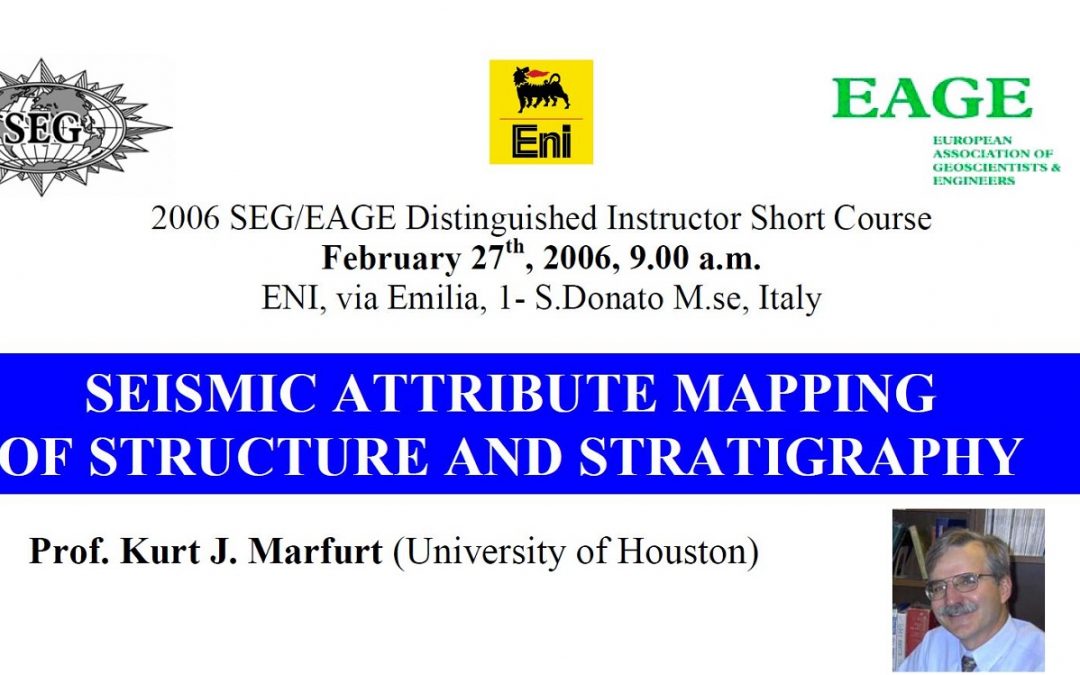Prof. Kurt J. Marfurt (University of Houston)
SEISMIC ATTRIBUTE MAPPING
OF STRUCTURE AND STRATIGRAPHY
2006 SEG/EAGE Distinguished Instructor Short Course
February 27th, 2006, 9.00 a.m.
ENI, via Emilia, 1- S.Donato M.se, Italy
ABSTRACT
Seismic data are incredibly rich in information, including amplitude, frequency, and the configuration or morphology of reflection events. Seismic attributes, including volumetric estimates of coherence, dip/azimuth, curvature, amplitude texture, and spectral decomposition, can greatly accelerate the interpretation of newly acquired 3D surveys as well as provide new insight into old 3-D surveys. Successful use of seismic attributes requires both an understanding of seismic data quality and of sedimentary and tectonic processes. Participants in this one-day course will gain an understanding of the physical basis, geologic expression, and petrophysical calibration of seismic attributes. This course will address the following questions:
- How can we use attributes to accelerate the interpretation of very large data volumes?
- What is the impact of seismic acquisition and processing on attribute images? Can we use attributes to help choose processing parameters?
- What is the physical basis for modern volumetric attributes, including coherence, dip/azimuth, curvature, amplitude gradients, textures, and spectral decomposition?
- How do we display these attributes to provide the most information and to communicate important concepts to nontechnical members of our team?
- What is the attribute expression of clastic versus carbonate depositional environments? of extensional versus compressional deformation?
- How can we use geometric attributes and spectral decomposition to more accurately define the reservoir model? Participants will be able to take home and use the answers and methods discussed in this course.
WHO SHOULD ATTEND
- seismic interpreters who want to extract more information from their data.
- seismic processors and imagers who want to learn how their efforts impact subtle stratigraphic and fracture plays
- sedimentologists, stratigraphers, and structural geologists who use large 3-D seismic volumes to interpret their plays within a regional, basin-wide context
- reservoir engineers whose work is based on detailed 3-D reservoir models and whose data are used to calibrate indirect measures of reservoir permeability
Advanced knowledge of seismic theory is not required; this course focuses on understanding and practice.
BIOGRAPHY
Kurt Marfurt began his geophysical career as an assistant professor teaching mining geophysics at Columbia University’s Henry Krumb School of Mines in New York. After five years, he joined Amoco at what was then called its Tulsa Research Center. Through successive reorganizations at Amoco, Marfurt has obtained diverse experience in seismic modeling, migration, signal analysis, basin analysis, seismic attribute analysis, reflection tomography, seismic inversion, and multicomponent data analysis. Through Amoco, he won five patents, two in seismic coherence technology. He is the author of several dozen articles and coeditor of two books published by the SEG and has received both the SEG Best Presentation award for work on seismic modeling (1989) and SEG Best Paper award for work on seismic coherence (1999). Marfurt joined the University of Houston in 1999 as a professor in the Department of Geosciences and as director of the Center for Applied Geosciences and Energy (CAGE), where his primary emphasis is on the development and calibration of new seismic attribute technology. He is a member of GSH, SEG, EAGE, AAPG, and AGU, and has served 16 years as an associate or assistant editor for geophysics.


Recent Comments